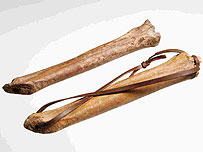
Ice Skating - Medieval Style!
The capital's ice rinks are nothing new - Londoners have been skating since the 12th Century on rather unusual skates...
Somerset House is just one of many amazing ice rinks to be found in London this year but ice skating in the capital is nothing new. A new exhibition, Medieval London, includes a pair of ice skates dating back to the Medieval times.
The skates, made from cattle bones, have been found around the Moorfields area of the city. They would have been strapped to the feet as Londoners took to the frozen marshes using a special stick to glide across the ice.
Skaters either lost their skates or threw them away at the end of the season where they have since been discovered. The marshy earth helps to preserve the bone for so long .
William FitzStephen, one of Thomas Becket's clerks, described in the 1170s how Londoners would go out to the frozen marshes of Moorfields in the winter. They 'fit to their feet the shinbones of cattle and push themselves across the ice using a stick with an iron spike on the end'
'When the great marsh that washes the Northern walls of the City is frozen, dense throngs of youths go forth to disport themselves upon the ice. Some gathering speed by a run, glide sidelong, with feet set well apart, over a vast space of ice. Others make themselves seats of ice like millstones and are dragged along by a number who run before them holding hands. Sometimes they slip owing to the greatness of their speed and fall, everyone of them, upon their faces'.
So how far back do teenage yobs and binge drinking go? What did Londoners feel about the worst epidemic the city has ever known? Where did London go for 200 years? And who bought all those hot sheep’s feet? The answers to these and other questions can be found in the Museum of London’s new Medieval London gallery opening on 25 November.The gallery tells the story of London from the end of Roman rule in AD410 to the accession of Elizabeth I in 1558, a period when London survived near extinction to become England’s capital and one of the most prosperous cities in Europe.
No comments:
Post a Comment